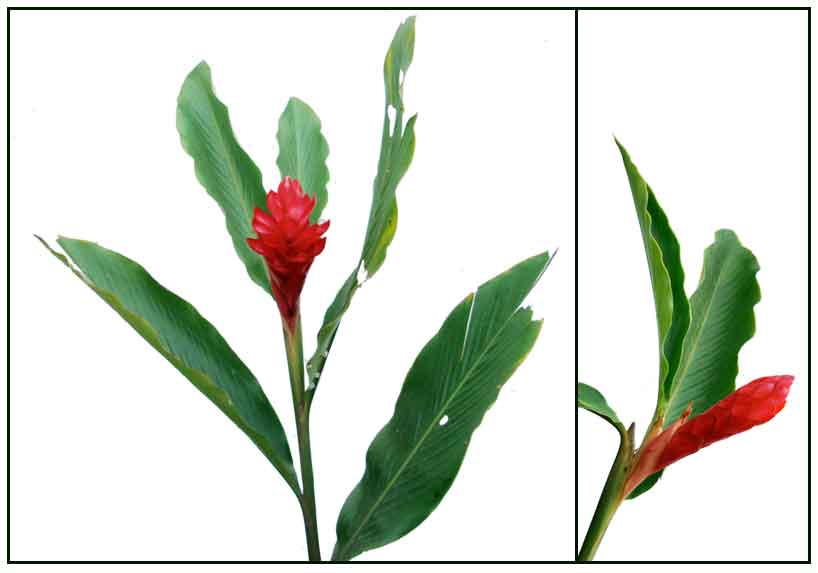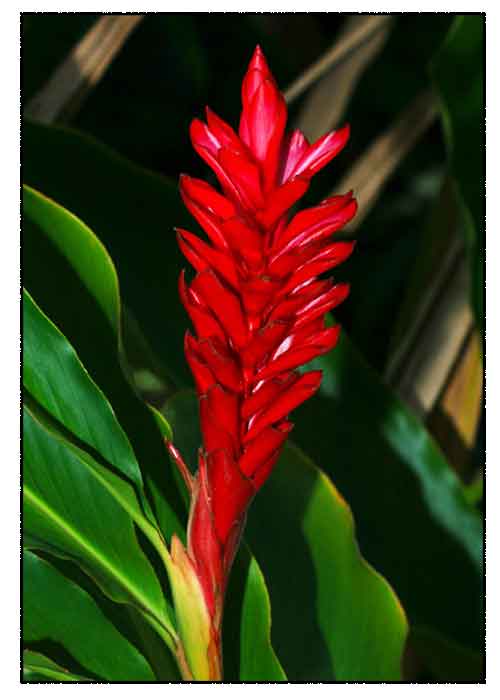| 
Gen info
- Alpinia purpurata have long brightly colored red bracts, which look like the bloom. but the true flower is the small white flower on top.
-
In Samoa, it is the national flower, locally called "teuila". (25)
Botany
Luyang-pula is a tall, upright, rhizomatous perennial, leafy herb forming
large clumps, growing to 3-4 meters tall. Leaves are lanceolate, glabrous.
Inflorescence is a terminal spike, often pendulous, showy, up to 90
centimeters long. Flowers are small, white, 1 or 2 , arising from the red bracts
of the spike, 2.5 centimeters long. Fruit is a capsule. Pseudostems formed by leaf sheaths emerge from underground rhizomes.
Distribution
- Recently introduced to the Philippines.
- Ornamentally cultivated.
- Widely cultivated and naturalized in the tropics.
- Native to Bismarck Archipelago, Maluku, New Caledonia, New Guinea, Solomon Is., Vanuatu.
(5)
 Constituents Constituents
- Subextracts of leaves yielded a mixture of C28-C32 fatty alcohols, a 3-methoxyflavone and two steroid glycosides. The two latter metabolites were identified as kumatakenin, stiosteryl-3-O-6-palmitoyl-ß-D-glucoside and ß-sitosteryl galactoside. (see study below) (6)
- Essential oil of A. purpurata leaves and flowers yield a predominance of α-pinene, β-pinene and 1,8 cineol.
- Study of essential oil of inflorescences showed A. purpurata to be composed mainly by mono- and sesquiterpenes. The major compounds were ß-pinene and α-pinene, trans-caryophyllene, camphene, and 7-epi-α-selinene. (see study below) (17)
- Phytochemical evaluation of an n-hexane leaf extract yielded alkaloids, terpenoids, flavonoids, steroids, cardioglycosides, oils and fats, tannins and carbohydrates. (18)
-
GC-MS analysis of n-hexane leaf extract yielded 4-morpholinomethyl-7-methoxycoumarin (1.42%), methanesulfonate of (3R,4S)-3-propargyloxy-4-[(R)-1-hydroxy-3-phenyl-3-butenyl]-1-(p-methoxyphenyl)-2-azetidinone (2.28%), 5-butyl-3-methyl-1,2,3, 8a-tetrahydroindolizine (6.48%), phenol, 4-(3,7-dimethyl-3-ethenylocta-1,6-dienyl)- (6.99%), 1-naphthalenepropanol, α-ethenyldeca hydro-α,5,5,8a-tetramethyl-2-methylene-[1S-[1α (R*),4aα, 8aà]]-(9.29%), methenolone (10.93%), and nonanamide, 5-hydroxy-5-methyl-2-(2-methylpropyl)-N-benzyl-(25.80%). (18)
- Study of flowers by GC/MS yielded 42 essential oil components with a-pinene, ß-pinene, and ß-caryophyllene as major constituents. (see study below) (20)
- α-Pinene, β-pinene and 1,8 cineol predominate predominate in the essential oil of leaves and flowers. (21)
- Study of hydroalcoholic crude extract of dried leaves for total phenols using gallic acid as standard yielded 15.6 mg GAE g-1. Flavonoids kaempferol-3-O-glucuronide and rutin were found in higher concentrations in EA and butanolic extracts. (22)
- HPLC study
of ethyl acetate and n-butanol fraction yielded total flavonoid of 46.48 mg EQ/g and 68.50 mg EQ/g, respectively. The EA fraction yielded quercetin content of 5469.64 mg/kg and rutin of 4955.50 mg/kg; and from the n-butanol fraction, quercetin of 6737.14 mg/kg. (26)
Properties
- Studies suggest antioxidant, antimicrobial, antimycobacterial, anticancer, vasodilating, lhypotensive, larvicidal, antiurolithiatic properties.
Parts used
Bark, fruit, leaves and
seeds.
Uses
Folkloric
- No reported folkloric medicinal
use in the Philippines.
- In the West Indies, used
for stomach complaints.
- In Trujillo, Venezuela, oral use of boiled inflorescence used to treat cough symptoms. (21)
Others
- Nectar: Bees, butterflies and bird attracted to flower nectar. Studies
• Flavonoids / Leaves:
Study evaluated a hydroalcoholic extract of A. purpurata obtained from dried leaves. The flavonoids kaemferol-3-O-glucoronide and rutin were detected at higher concentration in the EA and butanolic extracts, with the latter showing highest flavonoid percentage (94.3%). (1)
• Volatile Oils / Leaves and Flowers: The major components
of leaf oil of A. purpurata were 1,8-cineole, ß-pinene and (E)-methyl
cinnamate; the oil from the flowers was dominated by ß-pinene
and a-pinene. (2)
• Vasodilator Activity: Study of extracts for vasodilator effects showed they were able to induce long-lasting endothelium-dependent vasodilation. Study showed a better vasodilator effect than control, results in agreement with the quantification of phenolic compounds in the extracts. It presents a possible natural source for bioactive compounds useful for the treatment of hypertension. (4)
• Antimycobacterial / Leaves: Study evaluated hexane and dichlormethane subextracts of leaves for antimycobacterial activity. In addition to anti-inflammatory activity, study also describes the phytochemical potential to treat tuberculosis. (see constituents above) (6)
• Antimicrobial / Rhizomes: Study evaluated three solvent extracts of leaves, roots, and rhizomes for in vitro activity against six strains of bacteria and four pathogenic fungi. Ethanolic extract of rhizomes showed wide spectrum of activity against all tested bacteria, with notable activity only with Candida albicans.
(7)
• Anticancer / Antioxidant: Study evaluated an ethyl acetate extract of AP for potential in-vitro antioxidant and anticancer activity.
Results showed concentration-dependent antioxidant activity. The extract showed potential anticancer
activity at 48 hours with IC50 of 130.20 g.ml-1 with a dose-dependent decrease in cell count for all concentrations tested. (8)
• Antioxidant / Leaves: Study evaluated the enzymatic and non-enzymatic antioxidants of leaf extract of Alpinia purpurata.
Results showed the potential to scavenge free radicals and protect against oxidative stress causing diseases. (9)
Study suggest ethanolic extract of Alpinia purpurata prevent oxidative damage in normal cells through its antioxidant property. (13)
• Novel CXC Chemokine Receptor-4 Inhibitors: CXCR4 is the receptor for chemokine, CXCL12 (stromal cell-derived factor-1, SDF-1) involved in problematic diseases like AIDS, cancer cell metastasis, leukemia cell progression and rheumatoid arthritis. Study aimed to identify the novel CXCR4 inhibitors from bioactive compounds in an EA extract of A. purpurata by GC-MS analysis. The EA extract yielded 32 bioactive compounds, some of which shows the better glide score compared with Cyclophosphamide (FDA approved drug). Results suggest the bioactive compounds may act as novel inhibitors for CXCR4. (10)
• Antibacterial: Study evaluated various extracts of leaves, roots, and rhizomes of Alpinia purpurata for antibacterial activity. Ethanol extracts of leaves and roots showed highest inhibition zone against E. coli and Lactobacillus. (12)
• Vascular Reactivity / Acute Hypotensive Effect / Leaves: Study evaluated the chemical profile, vascular reactivity, and acute hypotensive effect (AHE) of ethanolic extract of leaves of A. purpurata. Results showed a vasodilation action partially mediated by nitric oxide. Rutin-like flavonoids were quantified in the EEAP (1.8 ± 0.03%), and the total flavonoid and polyphenol rations were 4.1 ± 1.8% and 5.1 ± 0.3%, respectively. (14)
• Antibacterial / Anti-Cancer / Leaves: Study evaluated phytochemical constituents, antibacterial activity and anticancer activity of A. purpurata leaves. The EA extract of leaves showed antibacterial activity with a zone of inhibition from 5 to 14 mm at various concentrations. It also showed potential anticancer activity against PA1 ovarian cancer cell line with half MIC value of 110.25 µg/mL and dose-dependent decrease in cell count for all concentrations tested. (16)
• Essential Oil Toxicity to Maize Weevil: Study evaluated the toxicity of essential oil from Alpinia purpurata inflorescences to Sitophilus zeamais (maize weevil). No toxicity was noted when applied directly on the cuticle of insects. It showed toxicity to adult insects through fumigation with LC50 of 41.4 µL/L in air. (see constituents above) (17)
• Antioxidant / Cytotoxic / Apoptotic: Study evaluated a n-hexane leaf extract for antioxidant, cytotoxic, and apoptotic activities. Results showed antioxidant activity using DPPH, ABTS, reducing power and ferric reducing activity. In MTT assay, the extract inhibited HeLa cells in a dose dependent manner with IC50 of 41.25 µg/ml. Morphological changes suggested apoptotic activity in HeLa cells. (19)
• Larvicidal / Antibacterial / Essential Oil / Flowers: Oils from red and pink variants showed potent larvicidal activities against 4th instar Aedes aegypti with IC50 values of 80.7 and 71.5 ppm, respectively. Aqueous extracts of the two variants were active against dengue mosquito larvae (IC50 18.3 and 12.6%, respectively). Oils and aqueous extracts showed significant oviposition deterrent effects. Oil from the red cultivar showed significant inhibition of gram-positive and gram-negative bacterial growth. (see constituents above) (20)
• Free Radical Scavenging / Inhibition of Lipid Peroxidation / Rhizomes: Study evaluated an ethanolic extract of A. purpurata rhizome for free radical scavenging property in various in vitro models. Results showed inhibition of LPO and hydroxyl radical, NO radical, and superoxide radical scavenging abilities which could be attributed to the presence of phenolic and flavonoid compounds. (24)
• Anticancer / MNU and Testosterone Induced Prostate Cancer / Leaves: Study evaluated the invivo anticancer activity of A. purpurata in MNU (N-methyl N-nitrosourea) and testosterone induced prostate cancer induced in Wistar rats. Altered hematological, lipid parameters and prostate markers, renal and liver markers were brought back to normal upon treatment with ethyl acetate leaf extracts and standard drug finasteride. No toxicity effects were observed on the plant extract-alone treated group. Results suggest potential as an anticancer agent. (27)
• Inhibitory Effect on Struvite Crystals / Leaves: Study evaluated the inhibitory effect of methanol extracts of A. purpurata leaves on the growth of struvite crystals. With the increase in concentration of the extract, the weight of formed crystals gradually decreased. Results suggest that A. purpurata leaves have potential to inhibit formation of struvite crystals. The ME of leaves can promote the formation of ammonium magnesium phosphate hexahydrate crystals and reduced the nucleation rate of struvite crystals, a major component of triple phophate urinary stone. (28)
• Antitumor Effect on Struvite Crystals / Leaves: Study evaluated the inhibitory activity of red ginger bioactive compounds against antitumor AKT1 protein through in-silico analysis. Four identified bioactive compounds viz., rutin, sitosteryl 3-O-6-palmytoil-ß-d-glucoside, kumatakenin, kaempferol-3-o-glucoronide were used as ligand for molecular interactions. All bioactive compounds demonstrated good antitumor activity by binding to inhibitor site of AKT1 protein. Rutin displayed best potency as AKT1 inhibitor. Results suggest potential for the bioactive compounds as antitumor agents against cancer. (29)
Caution / Interactions
• Ginger supplements
should be avoided by those with known allergy to ginger or other Zingiberaceae
family members, including Alpinia purpurata.
• It has been suggested pregnant women should avoid ginger in
the excessive amounts (more than 1 gram dry weight per day). The German
Commission E recommends avoidance during pregnancy due to its possible
inhibition of testosterone binding in the fetus. It should not be used
for nausea of pregnancy and should be avoided by pregnant women with
a history of bleeding disorders and miscarriages. (see: Luya)
• Ginger decreases platelet adhesiveness and should be used with
caution by people on anticoagulant therapy.
• Increase Stomach Acid: Alpinia can increase stomach acid by decrease the effectiveness of antacids, H2-blockers (Pepcid, Axid, Zantac, Tagamet) and proton pump inhibitors (Nexium, Prevacid, Protonix, etc.) (23)
Availability
- Wildcrafted.
- Ornamental cultivation.
- Seeds in the cybermarket.
|

![]()

